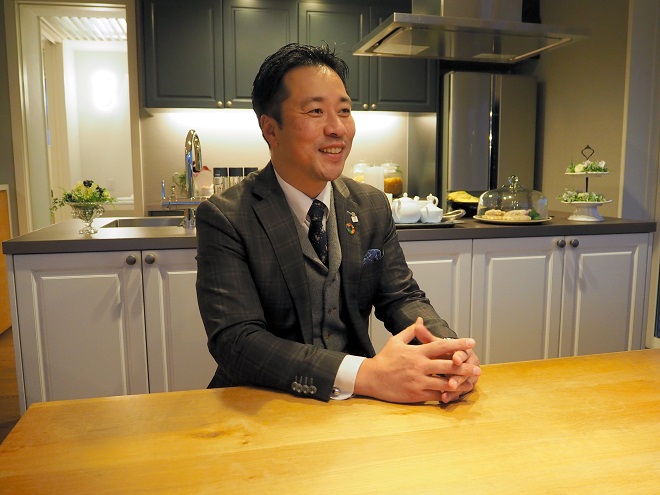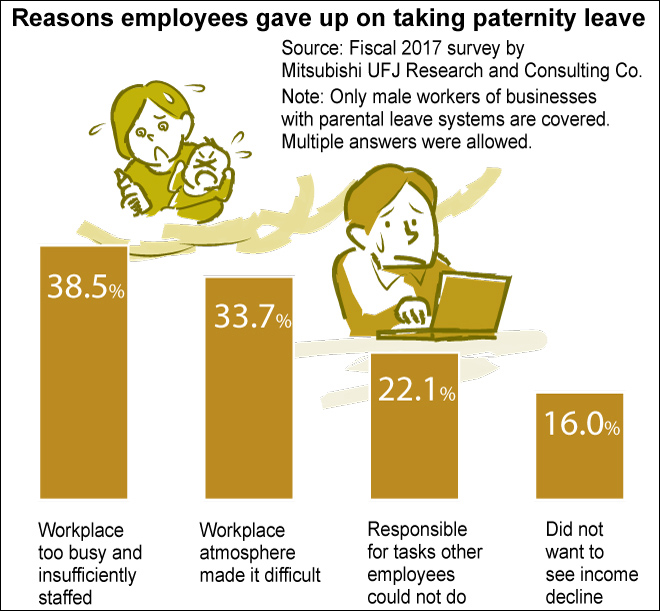Tackling paternity leave stereotypes in Japan

Noboru Hosokawa, an employee at Sekisui House Ltd., took a one-month paternity leave from his work at a model house park in Tokyo’s Setagaya Ward. – Credit: Suguru Takizawa
The Japanese archipelago has one of the most generous paternity leave systems in the world, yet few are the men who actually take advantage of it — namely due to long standing gender-role stereotypes. Some local governments and companies are trying to turn the tide.
By Kenjiro Takahashi, Natsumi Nakai, Suguru Takizawa, Sawa Okabayashi and Yoshinobu Matsunaga, Asahi Shimbun (Japan)
Japan’s parental leave system is considered one of the most family-friendly in the world. The scheme, which allows both men and women to stay home until their children turn one year old while still receiving 50% to 67% of their wages every month, was ranked in first place in the category of paid leave reserved for fathers by a 2019 UNICEF survey, out of the 41 top countries with such benefits. The leave can also be extended up to the child’s second birthday. Yet less than 8% of the working fathers in the country actually used the system in 2019 —compared to 83% of working mothers—, due to the stereotypes still looming over the leave.
Noboru Hosokawa, 46, manager of a model home park in Tokyo for a multinational construction company, was initially against taking paternity leave because he thought it would lead to consternation from his colleagues. “I was very busy with work and thought it was impossible to take the leave,” he said. “As a manager, I needed to improve sales, and mistakenly believed that taking paternity leave would undermine my image among my subordinates.”
The stereotype of husbands as breadwinners and housewives in charge of domestic and child care remains strong in Japan. Many men do not know that taking time to fully participate in their children’s upbringing could have a positive impact on women’s employment rates and help achieve gender equality — for which Japan has ranked a lowly 120th out of the 156 nations on the World Economic Forum’s (WEF) Global Gender Gap Index in 2020. Others have to face supervisors who believe that men’s main priority should be work, accuse their employees of being troublesome when they ask for time off to care for their children, or even cunningly threaten them with withholding potential promotions. Roughly 70% of nearly 3,000 businesses surveyed last summer by Japan’s Chamber of Commerce and Industry and the Tokyo Chamber of Commerce and Industry still “fully or somewhat oppose” a plan to oblige employers to make parental leave mandatory among male employees. But the national and local governments, as well as some companies, are trying to change that perspective.
Two years ago, Mr. Hosokawa used to spend little time with his then 5-year-old son and soon 3-year-old daughter, except on holidays. He had to leave home for work at 7:30 a.m. everyday, and often returned after 8 p.m., when the children were already in bed. When his children were born, Mr. Hosokawa was unaware that households like his —with a full-time housewife— were eligible for parental leave. And when he eventually found out that he could, he remained weary — no other managers around him had taken paternity leave.

Credit:The Asahi Shimbun
Top-down effort
The turning point came in 2018 when his company, Sekisui House Ltd., started urging employees with children under 3 years old to take paternity leave for a month or longer. The company’s President, Yoshihiro Nakai, initiated a top-down reform that led to gradual changes in company attitudes toward paternity leave, including paying in full the leave’s first month salaries to ease potential concerns among employees about losing income. At the time, Mr. Hosokawa’s daughter was about to turn 3, but he was still reluctant to take time off work. He finally agreed to enter the company’s paternity leave programme when his superior and other colleagues promised him they would take over his duties and support his team.
During his leave, Mr. Hosokawa cooked, washed clothes and spent so much time with his children that he developed lumbago. The pain made him realize how little he had done until then regarding household chores and child rearing. Today, he’s back at work helping prepare the paternity leave period of a junior staff member.
He now advises younger colleagues to “make full use of their time and spend it with their children, to see them grow.”
Father-friendly Gifu
Gifu Prefecture, located in the center of the country and east of Kyoto, has also taken a top-down approach in trying to raise the paternity leave ratio among its civil servants.
The prefecture has the highest ratio of the country, according to a 2019 survey conducted by Japan’s Internal Affairs Ministry — but only on prefectural government departments directly overseen by Gifu’s governor. Out of the 93 civil servants eligible in the prefecture’s departments, 48 —or 51.6% percent— took paternity leave in fiscal 2019, up 17.1 points from 34.5% in the previous year. A figure well above the national average of 16.8% of paternity leave among civil servants.
“A workplace atmosphere has emerged [in Gifu], where taking paternity leave is now normal,” said a representative of the internal affairs ministry’s Women’s Empowerment and Diversity Office. “It will be difficult for some places to spare personnel for certain reasons, but we expect that sharing the Gifu prefectural government’s measures will help municipalities and private corporations in the prefecture to improve their situations.”
Since 2015, the prefecture’s government has compelled staff who are expectant fathers to submit child care plans detailing the estimated delivery dates and whether they will take paternity leave. If they say they won’t, the human resources department encourages their supervisors to adjust the work schedule and motivate their subordinates to take time off for their children.
Gifu Prefecture now plans to raise its paternity leave ratio to 90%, but challenges remain ahead. When sections outside the governor’s direct jurisdiction are considered, Gifu actually ranks second nationwide, with a 13% paternity leave ratio among eligible employees, trailing only behind Tottori Prefecture’s 26%. The prefecture’s police department rate, for instance, stands at barely 5%, and the prefectural board of education at 4.9%. Private businesses and municipalities in Gifu are also struggling to raise their leave rates.
Examples such as these show that, however daunting breaking down long standing stereotypes may seem, Japan is slowly but surely moving toward a family-friendly society. By 2025, the country’s central government hopes to increase the paternity leave rate among local civil servants and private companies to at least 30%. Something that would not only benefit working fathers, but also help narrow the gender gap.

This article is being published as part of “Towards Equality”, an international and collaborative initiative gathering 15 international news outlets to highlight the challenges and solutions to reach gender equality.




